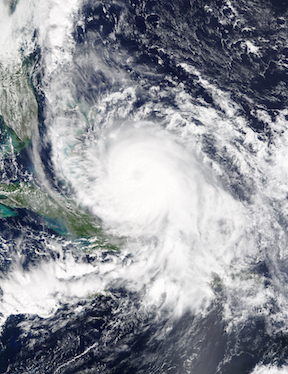- HOME |
- PEOPLE |
- RESEARCH |
- PUBLICATIONS |
- NEWS AND EVENTS |
- SEMINARS
The 2016 North Atlantic Hurricane Season: Penn State ESSC Forecast
 ESSC scientist Michael E. Mann, alumnus Michael Kozar, and researcher Sonya K. Miller have released their seasonal prediction for the 2016 North Atlantic hurricane season, which officially starts on June 1st and runs through November 30th.
ESSC scientist Michael E. Mann, alumnus Michael Kozar, and researcher Sonya K. Miller have released their seasonal prediction for the 2016 North Atlantic hurricane season, which officially starts on June 1st and runs through November 30th.
The prediction is for 18.9 +/- 4.4 total named tropical cyclones, which corresponds to a range between 14 and 24 storms with a best estimate of 19 named storms. This prediction was made using the statistical model of Kozar et al. (2012, see PDF here). This statistical model builds upon the past work of Sabbatelli and Mann (2007, see PDF here) by considering a larger number of climate predictors and including corrections for the historical undercount of events (see footnotes).
The assumptions behind this forecast are (a) the persistence of current North Atlantic Main Development Region (MDR) sea surface temperature (SST) anomalies (0.88 °C in late-April 2016 from NOAA’s Coral Reef Watch) throughout the 2016 hurricane season, (b) development of a La Niña (Niño3 anomaly of -1°C) in the equatorial Pacific during boreal Fall/Winter 2016-17 (Climate Prediction Center April 2016 ENSO Discussion), and (c) climatological mean conditions for the North Atlantic Oscillation in Fall/Winter 2016-17.
If no La Niña develops (Niño3 anomaly between +/- 0.5 °C), then the prediction will be lower: 16.1 +/- 4.0 storms (range of 12-20 storms with a best guess of 16).
Using an alternative model that uses "relative" MDR SST (MDR SST with the average tropical mean SST subtracted) in place of MDR SST yields a slightly lower prediction (11.4 +/- 3.4 total named storms). This alternative model also includes the development of a La Niña.
Previous Forecasts:
Year (click to see forecast) |
Prediction |
Best Guess |
Range |
Actual Count |
|---|---|---|---|---|
| 2007 | n/a | 15 | n/a | 15 |
| 2009 | 11.5 +/- 3.4 | 12 | 8-15 (6-13 if El Niño) | 9 |
| 2010 | 23.4 +/- 4.8 | 23 | 19-28 | 19 |
| 2011 | 16.25 +/- 4.0 | 16 | 12-20 | 19 |
| 2012 | 11.2 +/- 3.3 | 11 | 8-15 | 19 |
| 2013 | 16.0 +/- 4.0 | 16 | 12-20 | 14 |
| 2014 | 9.3 +/- 3.0 | 9 | 6-12 | 8 |
| 2015 | 6.9 +/- 2.6 | 7 | 4-10 | 11 |
References:
Kozar, M.E., Mann, M.E., Camargo, S.J., Kossin, J.P., Evans, J.L., 2012: Stratified statistical models of North Atlantic basin-wide and regional tropical cyclone counts, J. Geophys. Res., 117, D18103, doi:10.1029/2011JD017170.
Mann, M.E., Sabbatelli, T.A., Neu, U., 2007: Evidence for a Modest Undercount Bias in Early Historical Atlantic Tropical Cyclone Counts, Geophys. Res. Lett., 34, L22707, doi:10.1029/2007GL031781.
Sabbatelli, T.A., Mann, M.E., 2007: The Influence of Climate State Variables on Atlantic Tropical Cyclone Occurrence Rates, J. Geophys. Res., 112, D17114, doi: 10.1029/2007JD008385.
Vecchi, G.A., Knutson, T.R., 2008: On Estimates of Historical North Atlantic Tropical Cyclone Activity, J.Climate, 21, 3580-3600, doi:10.1175/2008JCLI2178.
Footnotes:
The tropical cyclone series was corrected based on an estimated historical undercount taken from Vecchi and Knutson (2008).
Image: Hurricane Joaquin, National Aeronautics and Space Administration, LANCE/EOSDIS Rapid Response, captured on Terra satellite - http://lance-modis.eosdis.nasa.gov/cgi-bin/imagery/single.cgi?image=Joaquin.A2015275.1530.250m.jpg
Prediction made: 25 April 2016
This webpage last updated: 27 April 2016

